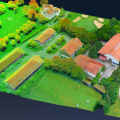
Department of Primary Industry scientists are using satellite imagery to determine crop nitrogen levels with the view of developing technology to help grain growers determine fertiliser applications.
DPI senior research scientist Glen Fitzgerald estimates that technology that can estimate crop nitrogen requirements would be available to farmers within three to five years.
The DPI has been working with scientists from the University of Melbourne, the Queensland University of Technology, Michigan State University and Italy's University of Basilicata for several years on the system.
Dr Fitzgerald said the researchers were using satellites to develop a remote sensing index which ascertained the crop's nitrogen status by its "greenness", by combining remotely sensed characteristics such as biomass, chlorophyll and water levels.
Currently, tissue testing is required to determine nitrogen requirements of crops, but this is time-consuming, and covers only small sample areas. Satellite detection would allow whole fields to be analysed, easily locating areas requiring fertiliser.
"This research creates the potential for developing a whole paddock analysis of nitrogen levels rather than taking tissue samples at selected points in the crop and waiting several days for the results.
"In addition, the method provides an assessment of nitrogen throughout a paddock, unlike the limited spatial assessment from tissue samples.
"Real-time in-crop assessment will help farmers determine where to increase or decrease nitrogen across the whole crop."
Dr Fitzgerald added that the satellite-based technology could eventually be developed to provide variable rate fertiliser applications using precision agriculture systems.
Dr Fitzgerald said commercial equipment which showed nitrogen levels relative to other parts of the crop was already available, but did not provide actual fertiliser requirements in kilograms a hectare.
"In reality, these sensors give a relative measure (of nitrogen levels). They can tell you this part of a crop has more nitrogen than that part," he said.
"But they are not measuring nitrogen levels directly."
Dr Fitzgerald said scientists were now getting to that point where they could give quantitative measurements of nitrogen in crops.







